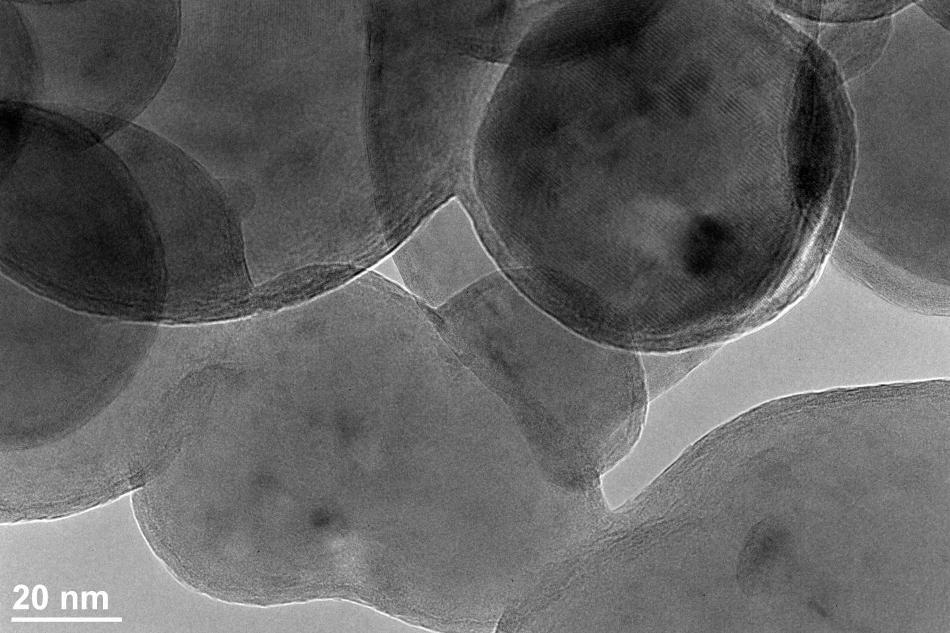Jun 12 2018
Army scientists have demonstrated that energetic performance can be considerably improved by mixing TNT with aluminum nanoparticles. It is anticipated that this explosive finding will increase the reach of the U.S. Army firepower in the war front.
 Native aluminum particles at 150,000x magnification. (Image credit: ARL)
Native aluminum particles at 150,000x magnification. (Image credit: ARL)
Scientists from the U.S. Army Research Laboratory and Texas Tech University showed nearly 30% improvement in the detonation velocity of TNT through the addition of innovative aluminum nanoparticles in which the native alumina shell is substituted with an oxidizing salt known as aluminum iodate hexahydrate, or AIH.
High-resolution transmission electron microscopy (TEM) was carried out by Dr Chi-Chin Wu from ARL, a materials researcher who leads the plasma research for the lab’s Energetic Materials Science Branch in the Lethality Division of Weapons and Materials Research Directorate, to unearth the structure of the AIH-coated aluminum nanoparticles for the first time ever.
According to Wu, this revolutionary study opens the door for the use of aluminum and prospectively other metallic nanoparticles in explosive formulations to increase the range and destructive power of Army weapons systems, which is the main aim of the Army’s “Long Range Precision Fires” modernization priority.
We believe these results show tremendous promise for enhancing the detonation performance of conventional military explosives with aluminum nanoparticles for the first time.”
Dr. Jennifer Gottfried, Co-Author
This path-breaking study has been described in a paper titled “Improving the Explosive Performance of Aluminum Nanoparticles with Aluminum Iodate Hexahydrate (AIH)” the published on May 28, 2018, by Jennifer L. Gottfried, Dylan K. Smith, Chi-Chin Wu, and Michelle L. Pantoya in the high-impact journal Scientific Reports.
The researchers discovered that the AIH shell effectively protected the crystalline aluminum core against undesirable oxidation, where the shell looks like protruding nodules on the aluminum surface.
This special morphological feature and the innovative core-shell structure improve the reactivity, which was exhibited by laser-induced air shock from experiments on energetic materials, a novel laboratory-scale energetic testing technique devised by Gottfried.
In this technique, the sample is impacted upon with a focused, high-energy laser pulse to intensely disintegrate the explosive molecules.
When the laser interacts with the material, a laser-induced plasma is produced as well as a shock wave that expands into the ambient air. Then, the energy liberated from an explosive sample can be experimentally calculated by evaluating the laser-induced shock velocity using a high-speed camera.
A long time ago, it was hypothesized that aluminum nanoparticles have the ability to improve the energetic performance of propellants and explosives due to their high energy content and potential for fast burning.
This is due to the fact that they have extremely large surface areas than their total volume and a very large heat of reaction.
Yet, the surface of the aluminum nanoparticles gets naturally oxidized in air to produce a thick alumina shell, usually 20% by weight.
This shell decreases the energy content of the nanoparticles by minimizing the amount of active aluminum; it can also reveal the rate of release of energy since it functions as a barrier to the reaction of the aluminum with the explosive. Hence, the explosive performance can be considerably enhanced by replacing the oxide shell, as successfully accomplished by TTU.
The researchers will now carry out additional energetics studies with aluminum nanoparticles in collaboration with the U.S. Army Research, Development and Engineering Command at Picatinny Arsenal, New Jersey, and the Air Force Research Laboratory.
It is very exciting to advance science to a point where we can harness more chemical energy from metal particles at faster timescales. This is an exciting time for transforming energy generation technology.”
Professor Michelle L. Pantoya, Texas Tech University.